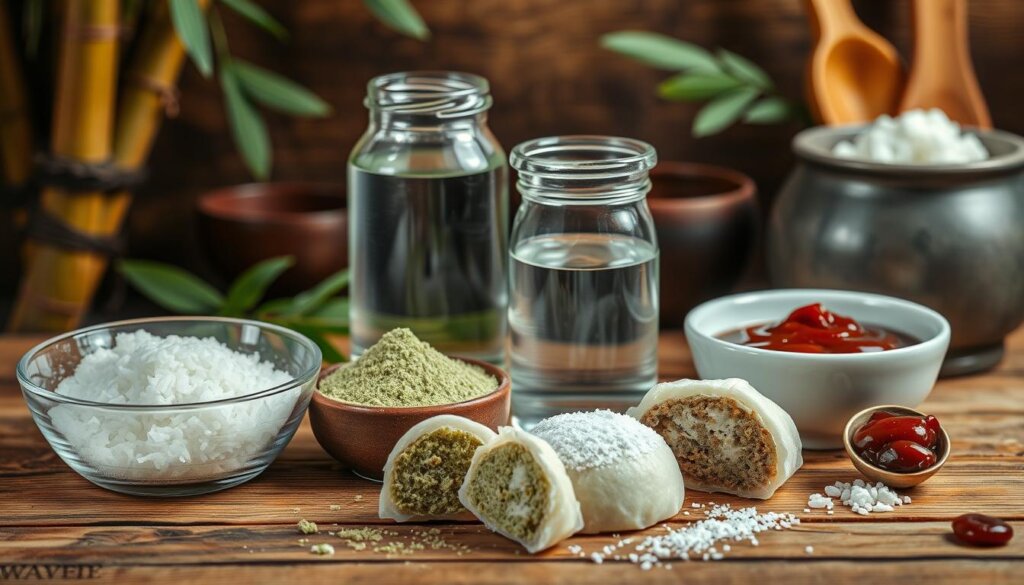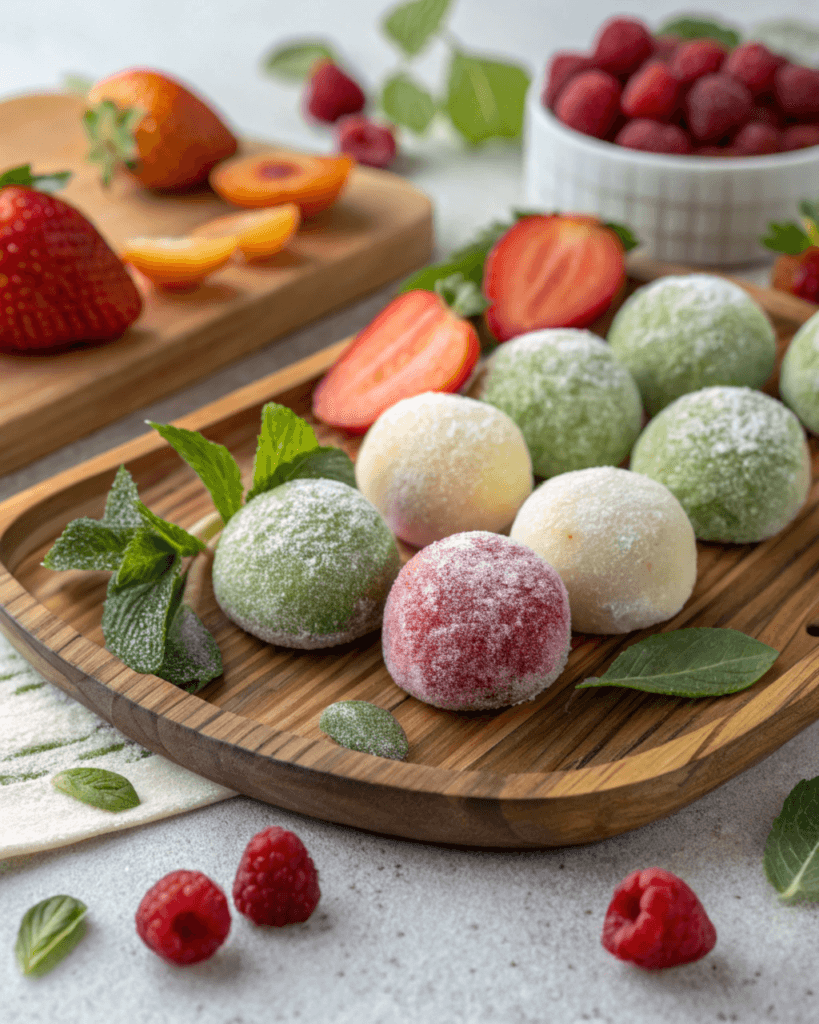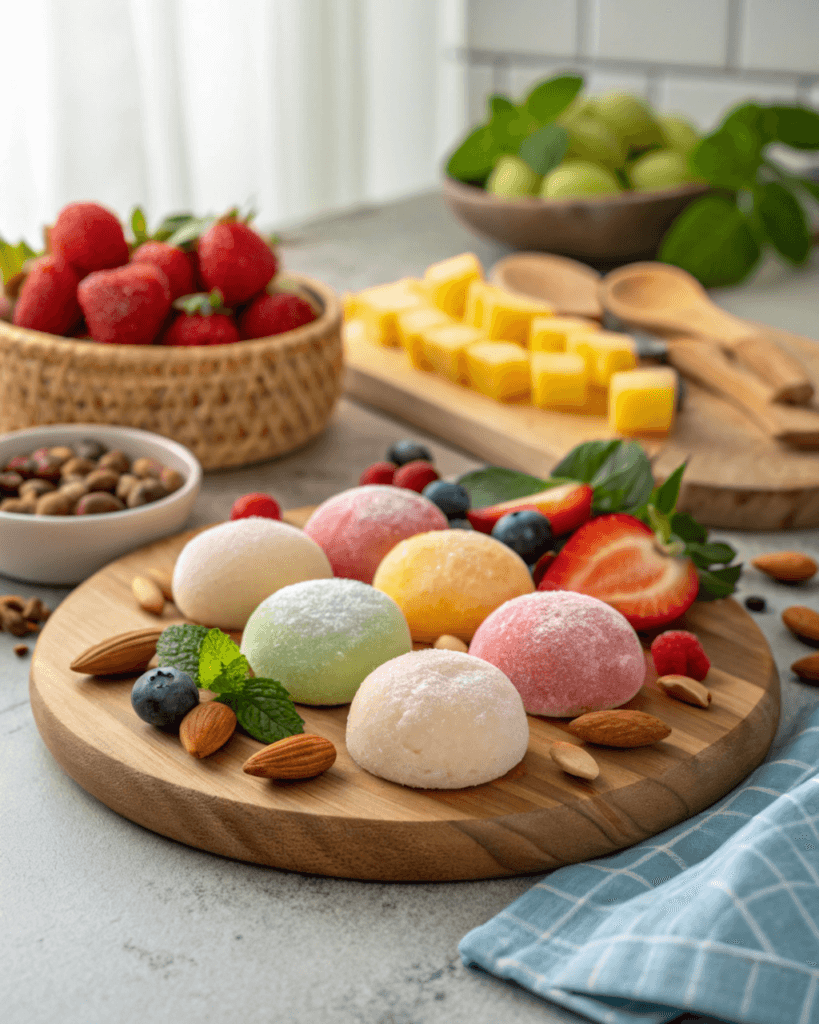Ever thought about mochi being safe for those who can’t eat gluten? This traditional Japanese dessert is made from glutinous rice, which naturally doesn’t contain gluten. However, knowing if mochi is truly gluten-free is key for those with gluten sensitivities or celiac disease.
In this guide, we’ll delve into mochi’s history, its classic ingredients, and health benefits. Plus, explore newer versions like gluten-free mochi ice cream. For more gluten-free options, check out tips for gluten-free desserts, how to make perfect gluten-free cookies, and gluten-free substitutes for popular ingredients. Enjoy a sweet treat without the worry!
Table of contents
What is Mochi?
Mochi is a tasty Japanese treat made from glutinous rice. It’s known for its chewy texture and many flavors. This treat is a big part of Japanese food culture.
Origins and Cultural Significance
Mochi has been around for centuries, mainly during Japanese New Year. It brings joy and prosperity, making it a favorite at special times. In Japan, making mochi is a family tradition.
They pound steamed rice into a sticky dough. This strengthens family bonds and keeps traditions alive.
Traditional vs. Modern Mochi
Traditionally, mochi is enjoyed plain or with savory and sweet fillings. Now, mochi ice cream is a hit worldwide. It shows how mochi has changed while keeping its roots.
Ingredients of Mochi
Mochi is a tasty treat made from glutinous rice, also known as sweet rice. This rice makes mochi chewy and elastic. The rice is pounded into a smooth, sticky dough to make this versatile delicacy.
Glutinous Rice and Its Properties
The main mochi ingredients are glutinous rice flour. This flour makes mochi chewy. When heated, the proteins in the flour make it elastic, creating mochi’s beloved texture. This rice is gluten-free, making it good for many diets.
Commercial Ingredients to Consider
This Commercial mochi often has extra ingredients for flavor and texture. Commercial mochi ingredients might include sugars, preservatives, and flavors like taro and vanilla. It’s important to check labels for gluten, as some products might have it.

Is Mochi Gluten-Free?
To know if mochi is gluten-free, we need to look at its main ingredient, glutinous rice. This Japanese treat is made from mochigome or glutinous rice. It doesn’t have gluten. But, people with celiac disease or gluten sensitivities should be careful.
The Truth About Glutinous Rice
Mochi is made from mochiko, a special rice flour. It’s chewy and doesn’t have gluten. So, the answer to is mochi gluten free is yes, in its traditional form. But, remember that the making process can sometimes add gluten risks. Always choose gluten-free mochi for those with celiac disease.
Potential Gluten Cross-Contamination
Gluten cross-contamination is a big worry when mochi is made in places that also handle wheat. This can be dangerous for people with gluten allergies. Look for brands that say their mochi is gluten-free. Always check the packaging or ask the manufacturer.
Health Benefits of Mochi
Mochi is not just tasty and fun to eat. It also has health benefits that help you live well. It’s a great choice for those watching their fat intake.
Nutritional Value and Low Fat Content
Mochi is made from glutinous rice, which is good for those with gluten issues. It’s low in fat, making it perfect for those looking for healthier desserts. It also has iron, magnesium, and zinc, which are good for you.
Energy Source and Essential Minerals
Mochi is full of carbs, giving you quick energy for the day. It has B vitamins to help your body use energy well. It also has low sodium and resistant starch, which is good for your gut.
Versatility for Dietary Preferences
Mochi is great in many recipes, making it very versatile. You can fill it with fruits, nuts, or other healthy stuff. Its sweet taste means you might not need to add much sugar, making it a healthy dessert option.
| Health Benefits | Description |
|---|---|
| Low-Calorie Dessert | Mochi is low in fat, making it suitable for weight management. |
| Energy Boost | This treat provides quick energy through its carbohydrate-rich content. |
| Essential Minerals | Contains iron, magnesium, and zinc supporting overall health. |
| Dietary Versatility | Can be tailored with various fillings, addressing diverse dietary preferences. |
| Low Sodium | Suitable for those monitoring their sodium intake. |

Who Should Avoid Mochi?
Mochi is a tasty treat for many, but some should be careful or avoid it. Knowing who should not eat mochi helps avoid bad reactions and keeps eating safe.
Allergies and Sensitivities
People with mochi allergies, like those allergic to rice or rice flour, should not eat it. About 13% of the world’s people are gluten sensitive. Those with gluten issues need to watch labels closely. Some mochi may have gluten, which is bad for those with celiac disease.
Choking Hazards and Dietary Restrictions
Mochi’s chewy texture is a choking hazard for young kids and the elderly. They might have trouble chewing and swallowing it. This could lead to choking.
Also, people with diabetes should be careful because mochi has a lot of carbs. Knowing your dietary limits is key to making good food choices.
Popular Variants of Mochi
Mochi comes in many tasty types, pleasing both old fans and new food lovers. You’ll find everything from classic mochi to new, exciting flavors. Your taste buds will thank you.
Mochi Ice Cream and Creative Flavors
Mochi ice cream is a big hit, blending mochi’s chewiness with creamy ice cream. Brands like Mochidoki offer fancy flavors like matcha, chocolate, and seasonal treats. It’s a sweet treat that’s both cool and yummy, perfect for dessert fans.
Gluten-Free Alternatives to Traditional Mochi
Looking for gluten-free mochi? There are great options like dango and Korean tteok. They have the same fun texture but are gluten-free. These gluten-free mochi alternatives let you enjoy many flavors while sticking to your diet. For more info, check out this guide to all types of mochi.

Making Your Own Gluten-Free Mochi
Making homemade gluten-free mochi is fun and rewarding. You need just a few ingredients and simple steps. A basic recipe uses 250 cc of glutinous rice, 200 cc of water, and 1 to 2 tablespoons of mochiko or rice flour. Follow these steps for a tasty and soft treat.
Simple Steps for Homemade Mochi
First, soak glutinous rice in water for 12 to 14 hours. Then, blend the rice with water until smooth. Microwave the mix for 10 minutes, stirring every 1 to 2 minutes.
Watch as it turns from white to yellowish sticky dough. Let it cool until warm. This makes about 2 cups of gluten-free mochi pieces.
Customization Options for Fillings
Homemade gluten-free mochi offers endless filling options. Try traditional sweet red bean paste or modern fillings like fruits, chocolate, or ice cream. You can make each piece unique with your favorite flavors.
Conclusion
Mochi can be a tasty gluten-free dessert, made from glutinous rice. This rice is naturally gluten-free. It’s a great choice for those who follow gluten-free diets.
But, be careful with commercial mochi. Some may have gluten in fillings or coatings. Always check the ingredients to enjoy mochi safely.
Mochi is more than just a sweet treat. It’s also rich in culture and health benefits. Eating it in moderation can help with weight loss.
It’s also a good choice for those with dairy allergies. Pure mochi is a great dairy-free option.
Making your own gluten-free mochi lets you try different fillings. You can make it your own way, whether traditional or new. It’s fun and delicious to add to your gluten-free diet.
FAQ
Is mochi gluten-free?
Traditional mochi is made from glutinous rice, which is naturally gluten-free. But, it’s important to check commercial products for gluten. This is because of possible cross-contamination or added ingredients.
What ingredients are used to make mochi?
Mochi is mainly made from glutinous rice pounded into a sticky dough. Some commercial mochi may have extra flavors, preservatives, or sweeteners. These could include gluten.
Can people with celiac disease eat mochi?
People with celiac disease can eat mochi if it’s made from pure glutinous rice. It must be free from gluten contamination. Always check the ingredient labels to be sure.
Are there any health benefits of eating mochi?
Yes, mochi is low in fat and gives quick energy because it’s rich in carbs. It also has important minerals and B vitamins. This makes it a healthy choice.
Who should avoid eating mochi?
Those with rice allergies or gluten sensitivities should avoid mochi. Young children and older adults should also stay away. This is because of its chewy texture, which can be a choking hazard.
What are some popular variants of mochi?
Popular mochi types include mochi ice cream. It combines the chewy mochi with creamy ice cream in many flavors. Other options are rice-based treats like dango or Korean tteok.
How can I make mochi at home?
To make homemade gluten-free mochi, soak glutinous rice overnight. Then blend it into a dough and cook it. You can add sweet fillings like red bean paste, fruits, or ice cream.
What should I look for in mochi packaging?
When buying mochi, always read the ingredient labels. Look for gluten, cross-contamination warnings, and allergens. Also, check for certified gluten-free labels to be sure it’s safe.
Are all My/Mochi gluten-free?
No, not all My/Mochi products are gluten-free. Check the packaging for gluten-free certification, as some flavors may contain gluten.
Is mochiko celiac safe?
Yes, mochiko (sweet rice flour) is gluten-free and safe for celiacs, as it is made from glutinous rice, which contains no gluten.
Is mochi made from wheat?
Traditional mochi is made from glutinous rice, not wheat, and is naturally gluten-free. However, flavored or processed mochi may include gluten-containing additives. Always verify the ingredients.





